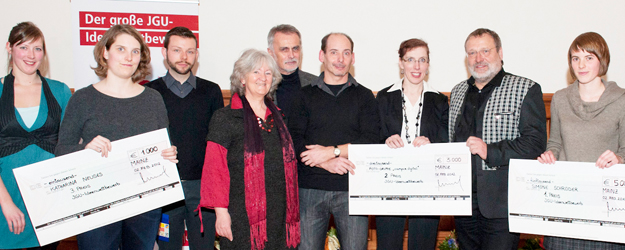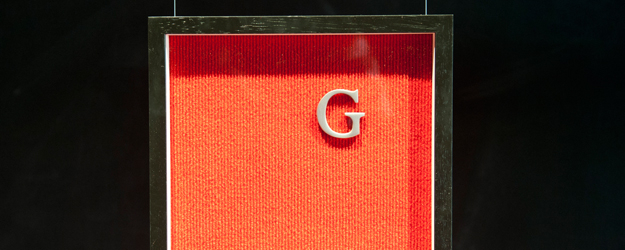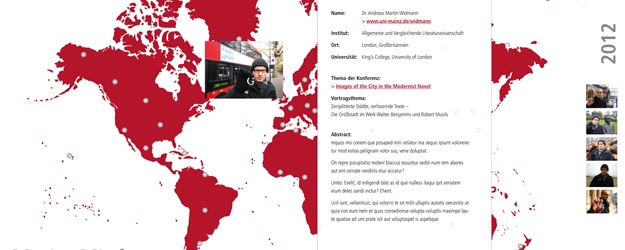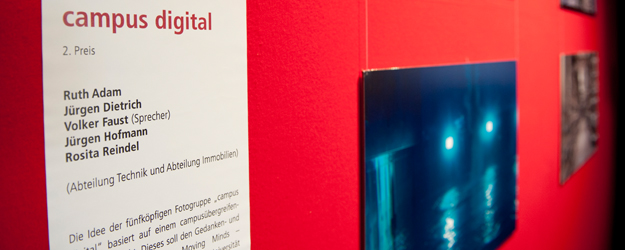25 January 2012
A special kind of world map, a photo gallery of JGU history, and a wall sculpture – these are the winning ideas developed by members of Johannes Gutenberg University Mainz (JGU) to embody the motto of its Institutional Strategy "THE GUTENBERG SPIRIT. Moving Minds – Crossing Boundaries."
Imagine yourself standing in Beijing, New York, Paris, or Nairobi, holding a small metal type in front of the camera – a "G" for Gutenberg. If you ask Simone Schröder, this is exactly what researchers from Johannes Gutenberg University Mainz should be doing around the world. With her novel idea, the student of Comparative Literature won the JGU-sponsored competition for concepts that can be used to express and illustrate the motto of the university's Institutional Strategy "THE GUTENBERG SPIRIT. Moving Minds – Crossing Boundaries" in a particularly original way. All JGU members – students and staff alike – were invited to participate in the contest. A EUR 5,000 prize awaited the winner while those coming second and third receive EUR 2,000 and EUR 1,000, respectively.
Moving Minds – Moving Mainz
"I had a bunch of ideas," says Simone Schröder. "But everyone I talked to said that this should be the one." Und the title "Moving Minds – Moving Mainz," the 25-year-old presented her idea for a digital world map linked to the university website. Markers on the map indicate all the places to which JGU academics travel, whether for research trips or conferences. Anyone who wants to know more can click on one of those markers for more information about who was there and why. The real crowning glory, however, is the photo of each of these researchers holding the letter "G" for Gutenberg University.
Schröder highlighted the advantages of her concept: "This idea is really inexpensive to implement and it can easily be expanded." And the link to Johannes Gutenberg is quite obvious: It's time for movable type to get moving around the world. The movement of researching "minds" is thus made tangible and the spread of the university's Gutenberg Spirit across borders becomes apparent.
A total of 65 submissions to the competition were made by both individuals and groups. A twelve-member jury, among them University President Professor Dr. Georg Krausch, selected nine candidates to go through to the second round of the competition. "They said that my idea had a lot to do with everyday academic life at the university," Schröder notes. This was one of the reasons why she won the first prize.
65 submissions from all over the university
Suggestions for how to represent the motto of JGU's Institutional Strategy came from all over the campus. Students and professors, lecturers and employees from a variety of university departments participated in the contest. Second prize went to "campus digital," a group of five talented amateur photographers who work in the Technical Services and Building Management departments. Their idea, entitled "JGU – Behind the Scenes," is to develop a photography project dedicated to cataloging the historical development of the campus from 1946 to 2012.
"We've already been displaying our photographs for four years now," explains Volker Faust of the "campus digital" team. "We've made places of work at the university our main theme. We're able to access places that hardly anyone else knows about." Accordingly, the idea behind these photographers' suggestion for the contest was to show new facets of university life from unusual perspectives.
A Gutenberg Spirit sculpture
The jury awarded third prize to a work of art. Katharina Neuses tells that her idea for the Gutenberg Spirit "came to me completely spontaneously." 12 o'clock was the deadline for submission and at 10 o'clock, the 25-year-old student from the Mainz Academy of Fine Arts sat down and created a wall sculpture. Neuses designed a tent-like sculpture made of different-colored triangles leaning against a white surface. This is a sculpture designed to not just to be looked at, but also to be accessed. Some of the individual elements will be made of wood and others of plexiglass. Depending on the angle from which the viewer looks at the sculpture, there will be a constantly changing interaction between the layers of various transparent and non-transparent triangles. The dynamic of the sculpture stands for the "Moving Minds" aspect, while the constantly changing color combinations represent the "Crossing Boundaries" concept. Despite the simplicity of its materials, the effect of the sculpture is extremely complex.
"My entire course of studies is interwoven into this sculpture," states Neuses. Three-sided surfaces are one of the primary motifs of her artwork. "It was a really exciting experiment to use my art to respond to something concrete," she adds. At the moment, there is still only a 50 centimeter high model that shows how Neuses conceives of the finished work of art. "I would really like to be able to do it in its full-sized version. It would be a shame if it just stays as a model."
The winners

(f.r.t.l.) Professor Dr. Ulrich Förstermann (Vice President for Research), Simone Schröder (1st Prize), the campus digital mainz team (2nd Prize) with Volker Faust, Ruth Adam, Jürgen Dietrich, Jürgen S. Hofmann and Rosita Reindel, Tobias Boll (extra prize winner), Katharina Neuses (3rd Prize), Anna Schleicher (extra prize winner)



